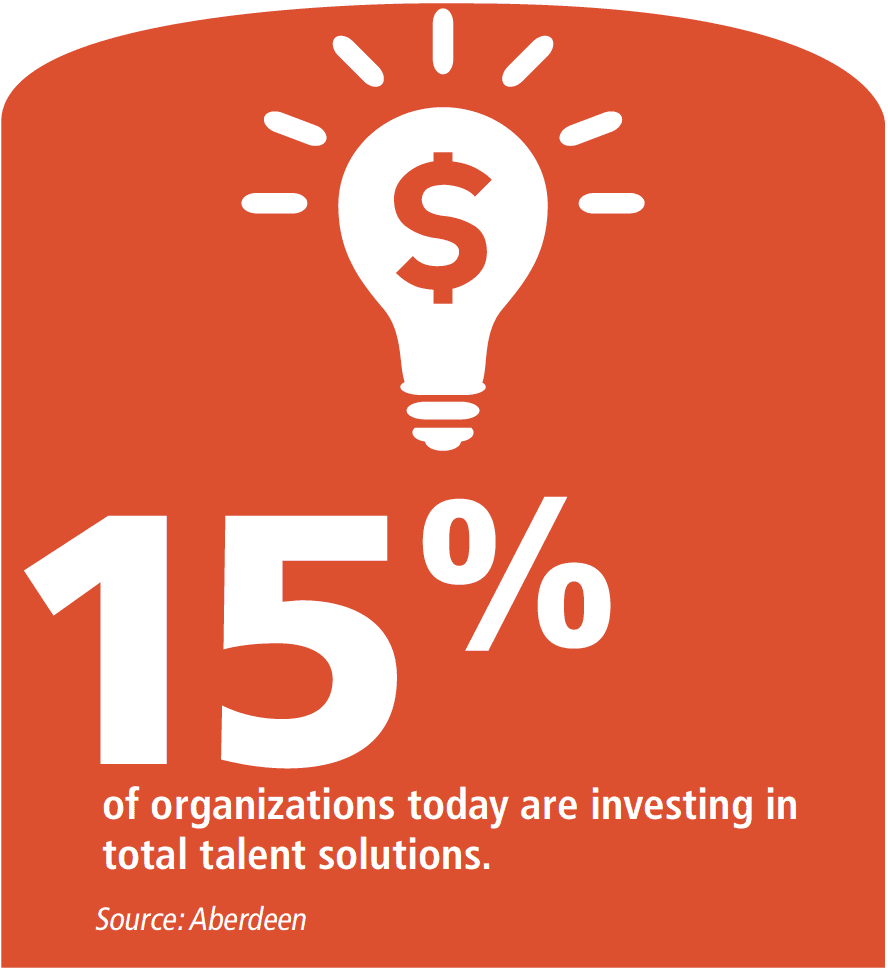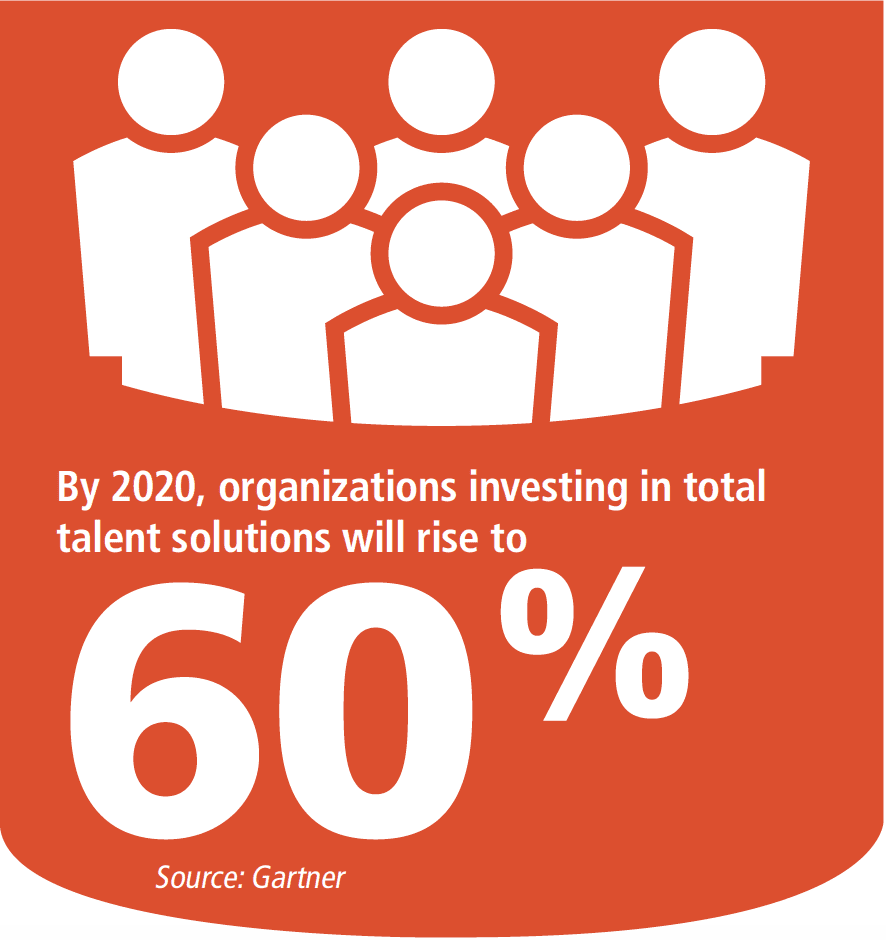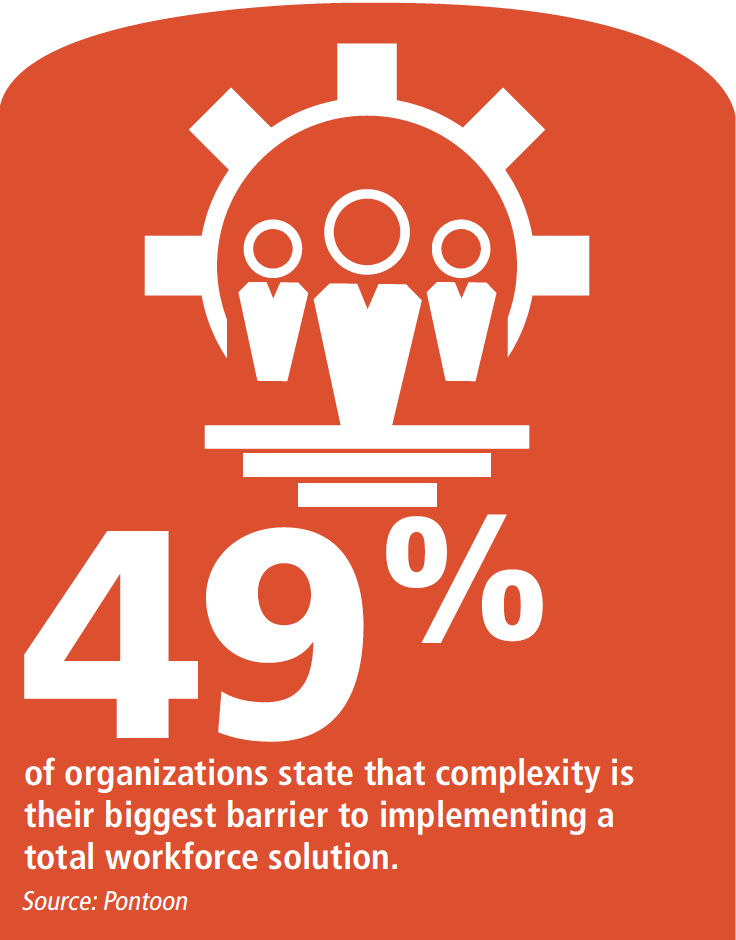Embrace the future of talent with a total workforce solution.
By Marta Chmielowicz
Gone are the days of one-size-fits-all sourcing, recruiting, and hiring. The gig economy is on the rise, the workplace is becoming more diverse, and top talent is increasingly hard to come by. But even as skills shortages become the norm and attracting talent grows more difficult, organizations are gearing up their hiring efforts to position themselves for future success. In fact, LinkedIn’s Global Recruiting Trends 2017 study reports that talent is the top priority for 83 percent of executives, and 56 percent of organizations are planning to increase their hiring volume in 2018.
But while talent is one of HR’s biggest priorities, it is also one of its greatest challenges. According to Pontoon’s Global Workforce Solutions Survey, 70 percent of survey respondents believe their organization’s talent acquisition strategy is incapable of delivering future-ready talent.
So, what’s a talent acquisition team to do? For many, the answer is adopting a holistic talent management strategy that aligns with business goals, encompasses all types of workers, and leverages technology to achieve integration and transparency.

For organizations that are considering taking the plunge into a total talent solution, the potential benefits are numerous:
- Better visibility. By combining recruitment process outsourcing (RPO) and managed service program (MSP) capabilities into one integrated platform, organizations can gain full visibility over their entire talent spectrum –from contingent workers to permanent employees in both internal and external talent funnels. This blended approach allows for smarter hiring decisions, leading to higher efficiency and better quality of hires.
“A total workforce solutions approach gives leadership a comprehensive view of their labor realities so they can make better, data-driven business decisions. Segmenting data and operations by worker classification is quickly becoming an outdated methodology in an economy where freelancers account for 35 percent of U.S. workers and collectively earned $1 trillion in the past year. Getting data and process flows out of employee classification silos gives companies the flexibility they need to stay ahead of their competition,” explains Peter Carvalho, president of AgileOne.
- Clearer insights. In today’s unpredictable and disruptive business environment, organizations need to be agile and adaptable in order to compete. Total workforce solutions can help by providing HR teams with more accurate data and analytics that can be used to predict future workforce challenges and proactively plan for the future.
“A total workforce solution platform will provide analytics regarding production, time, quality, and cost among others, including competitive compensation and market intelligence. It would also bring visibility to succession planning, internal mobility, and help business leaders understand if they are achieving specifically identified goals such as diversity,” says Lori Hock, CEO of Hudson Americas at Hudson Global Inc.
Data obtained from a total workforce solution platform can also inform other aspects of an organization’s broader HR strategy. “Through predictive analytics, companies can look beyond just managing the business need, but also glean how to effectively manage costs and productivity as well as guide recognition and employee value proposition,” Hock adds.
- Lower costs. “One of the biggest competitive advantages of a total workforce solution is cost avoidance or cost savings as a result of a holistic approach. If a hiring manager has a need, then they can discuss that need with their total talent provider. Collectively, based on market insights, budget, and knowledge of the business, a well-planned and strategic decision can be made to fill the need with the most cost-effective solution,” says Jones.

According to Carvalho, “Hiring more frequently and more quickly than your competition will make you a popular employer-of-choice and open more streams for your organization to complete work. This impacts your bottom line by making the organization more profitable and more popular than the competition.”
- Better results. PwC reports that 77 percent of CEOs see the availability of key talent as the biggest threat to their business. With access to talent presenting such a huge challenge for HR professionals, the adoption of a total workforce solution can help organizations ensure that they don’t fall behind.
“Having the ability to source all forms of talent from numerous talent pools means a higher likelihood of finding the very best and most suitable talent to achieve the optimum time to productivity and the right cost,” says Bruce Morton, executive director of enterprise strategy at Allegis Global Solutions.
In addition, “it affords an opportunity to be a market leader not only in hiring speed and quality, but also in efficiency since it reduces the need to return to the external talent market for every role,” adds Hock.
Despite these benefits, Aberdeen reports that only 15 percent of organizations today are investing in total talent solutions. However, that number is expected to increase, with research by Gartner predicting that by 2020, nearly 60 percent of HR leaders will leverage a unified talent management strategy for all types of talent.
Implementing a Total Talent Strategy
Organizations can follow this six-step process to successfully support the unified workforce of tomorrow:
1. Get an accurate view of the workforce. “It starts with a business needs analysis considering any market fluctuations, availability of workers, and future planning,” says Hock. “Don’t make assumptions. Just because certain processes are in place within your organization does not necessarily mean that all users are following them or that they remain current and efficient. Conduct a gap analysis or discovery session for an accurate view into what is occurring within the organization today.”
Armed with this information, HR professionals can develop and articulate a strategy to consolidate disparate systems. According to Morton, the key is to “start small, identify ways to gain visibility of current employees and available contract workers, then build a roadmap based on adding talent pools.”
However, it’s not enough to consider only current business performance; program success depends on alignment with future business needs. “Long-term resource planning is also required to ensure that the talent acquisition strategy aligns with the company’s strategic direction,” says Jones of Alexander Mann Solutions.
2. Reorganize the business. Such a dramatic change in the talent acquisition function requires a complete restructuring of the business. “Traditionally, permanent hiring has been dealt with via talent acquisition and HR, while contingent labor was owned by procurement. In some organizations the two never meet, and this disconnect isn’t helped by the fact that they use completely different technologies and have an entire ecosystem that has operated in silos,” Jones says. “All hiring, whether it’s internal, external, or contingent labor, should sit under talent acquisition and HR, with procurement providing input to ensure value is achieved, but not operationally owning the relationship.”
In order to successfully manage this change, organizations must create a role that has oversight over the full workforce. Hock of Hudson believes that “an experienced, effective team managing the program is critical to achieve optimal results. Their oversight of a consistent process will ensure that procedurally you proactively identify and mitigate risk, documenting all owners and actions to ensure compliance.”
Jones agrees and believes that this process needs to be driven from the very top of the organization. “First and foremost, you need a common owner, shared goals, and agreed objectives. You need to determine how success is going to be measured and then everybody needs to get on the bus. This has to come from the top down -from the C-suite. In most organizations, it can’t be effectively managed from the bottom up because the historical separation and reporting lines are too rigid.”
3. Secure buy-in from senior leadership. A recent Global Workforce Solutions survey by Pontoon revealed that 49 percent of respondents stated complexity was their biggest barrier to implementing a total talent acquisition approach, as it is difficult to change a process that has been in place for years.

“Critical to the success of such a fundamental change is the full involvement and active support of executive leadership,” AgileOne’s Carvalho explains. “Key stakeholders need to understand the full scope of issues that will be affected by the change and be given realistic timelines to execute. For example, the change to total workforce solutions will require merging HR, talent acquisition, and procurement. Executive leadership needs to consider the new organizational chart in advance and support the chosen leader and new objectives. This proactive clarity and organizational support naturally promotes collaboration.”
4. Invest in new technology. The next critical step to restructuring a traditional workforce model is the adoption of new technology that is better integrated across business functions. “You need an infrastructure to support the total workforce solution. This starts by reviewing your HRIS or other technology platform. Ultimately you will need systems that operate in unison to give you true visibility into spend, usage, and productivity… The program needs to be enabled by a technology that offers appropriate analytics and visibility and monitors the performance and utilization of resources against requirements,” says Hock.
In addition to improving efficiency, Carvalho believes that new technology can improve program implementation by mitigating compliance risks and providing every team member with one set of tools in pursuit of a unified goal.
5. Provide support, communication, and education. Managing the shift toward a total workforce solution requires frequent communication of the organizational strategy and performance goals. “Visibility promotes empathy and support brings collaboration,” says Carvalho. “The new organizational chart, frequent top-down communication, and shared performance goals will create a productive atmosphere.”
Demonstrating a business case for the initiative through concrete data is also a good strategy for getting team members on board. “The change management required is a lot easier if you take the guesswork out of the benefits of a combined strategy. Get the empirical evidence to make informed decisions together,” says Morton.
This combined with data sharing and training will better equip the entire organization to recommend and support additional change. “New departments may be adding new types of workers they haven’t used before, so educating the organization on the nuances associated with different worker types is essential,” Carvalho says.
6. Don’t be afraid to experiment. Even after adopting a total workforce solution, it is important that organizations don’t stifle their creativity in their approach to talent. “Express a true freedom to innovate in your approach, and don’t be afraid to hear new points of view or try new things,” advises Carvalho. “Learn from outcomes that are not successful and celebrate those that are. This isn’t the time for micro-management; trust your teams, your partners, and the process. Good things are on the horizon!”














